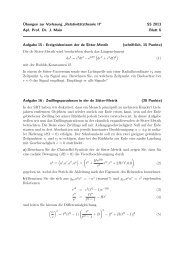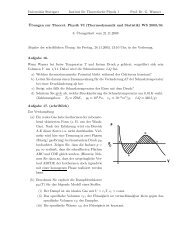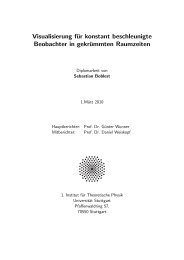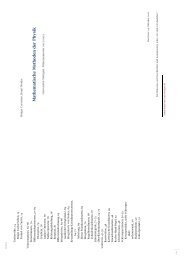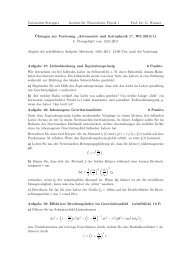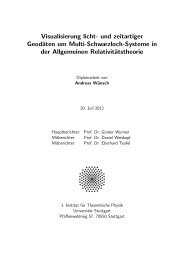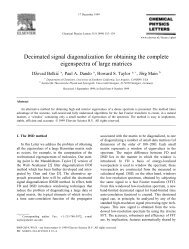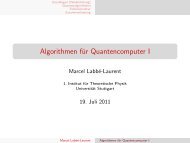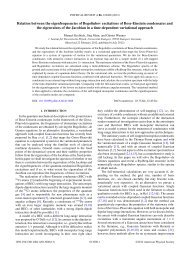The Gödel universe - Institut für Theoretische Physik der Universität ...
The Gödel universe - Institut für Theoretische Physik der Universität ...
The Gödel universe - Institut für Theoretische Physik der Universität ...
You also want an ePaper? Increase the reach of your titles
YUMPU automatically turns print PDFs into web optimized ePapers that Google loves.
D. Killing vectors<br />
Solving the Killing equations ξµ;ν+ξν;µ = 0 for <strong>Gödel</strong>’s<br />
<strong>universe</strong> yields five Killing vector fields (cf. [2]), which<br />
read<br />
ξ µ<br />
0 =<br />
ξ µ<br />
1<br />
ξ µ<br />
4<br />
where<br />
⎛<br />
⎜<br />
⎝<br />
= 1<br />
q(r)<br />
⎞<br />
1<br />
0 ⎟<br />
0<br />
⎠ , ξ<br />
0<br />
µ<br />
2 =<br />
⎛<br />
⎜<br />
⎝<br />
⎛<br />
1 ⎜<br />
= ⎜<br />
q(r) ⎝<br />
rG<br />
2<br />
rG<br />
2r<br />
− rG<br />
rG<br />
2r<br />
⎛<br />
⎜<br />
⎝<br />
⎞<br />
0<br />
0 ⎟<br />
1<br />
⎠ , ξ<br />
0<br />
µ<br />
3 =<br />
√r cos ϕ<br />
2c<br />
⎛<br />
⎜<br />
⎝<br />
0<br />
0<br />
0<br />
1<br />
⎞<br />
⎞<br />
⎟<br />
⎠ , (14a)<br />
<br />
1 + (r/rG) 2 sinϕ<br />
1 + 2(r/rG) 2 ⎟<br />
cos ϕ ⎠ , (14b)<br />
0<br />
√r sin ϕ<br />
2c<br />
2 1 + (r/rG) 2 cos ϕ<br />
1 + 2(r/rG) 2 ⎞<br />
⎟<br />
sin ϕ ⎠ ,<br />
0<br />
(14c)<br />
q(r) = 1 + (r/rG) 2 . (15)<br />
<strong>The</strong> first three Killing vectors (eq. (14a)) are trivial, corresponding<br />
to the constants of motion (13), and represent<br />
infinitesimal transformations in t, ϕ and z, respectively.<br />
Eqns. (14b) and (14c) reveal that a radial transformation<br />
generally affects time and angular coordinate as well.<br />
Note that lower indices in Killing vectors serve to distinguish<br />
different vector fields.<br />
Taking advantage of the Killing vectors (14), the generators<br />
of the corresponding Lie algebra read Xk =<br />
ξ α k ∂/(∂xα ). In this representation the structure constants<br />
Cijk follow from the Lie brackets [Xi,Xj] =<br />
CijkXk according to<br />
[X1,X2] = −[X2,X1] = −X4, (16a)<br />
[X2,X4] = −[X4,X2] = −X1, (16b)<br />
[X1,X4] = −[X4,X1] = 1<br />
X0 + X2, (16c)<br />
where [Xi,Xj] = XiXj − XjXi.<br />
ΩG<br />
(16d)<br />
It is worthwhile noting that the set of generators defined<br />
by L1 = X4, L2 = X1, L3 = −i(X2 + X0/ΩG) satisfies<br />
the angular momentum algebra [Li,Lj] = iεijkLk,<br />
as shown by Figuareido [24]. Here i,j,k ∈ {1,2,3} and<br />
εijk represents the three-dimensional Levi-Cevita symbol.<br />
Moreover, the remaining generators L0 = X0 and<br />
L4 = X3 commute with L1, L2 and L3. This feature is<br />
used e. g. in the analysis of the scalar wave equation in<br />
<strong>Gödel</strong>’s Universe [24, 25].<br />
III. SOLUTION TO THE GEODESIC<br />
EQUATIONS<br />
A. Geodesics for special initial conditions<br />
In this section, we will present the solution of the<br />
geodesic equations for special initial conditions. We consi<strong>der</strong><br />
arbitrary timelike and lightlike geodesics starting at<br />
the origin of the coordinate system. Lightlike geodesics<br />
alone had been consi<strong>der</strong>ed by Kajari et. al. [2]. Although<br />
the general solution to the geodesic equations is introduced<br />
in the next section, the special solution is necessary<br />
to overcome the coordinate singularity in r = 0. In<br />
principle, we could obtain the special solution from the<br />
general solution by applying the limit r0 → 0 for the<br />
initial radial coordinate r0. Unfortunately, this limit is<br />
complicated to calculate.<br />
<strong>The</strong> constants of motion, eq. (13), simplify for<br />
geodesics starting at the origin. In particular, k2 vanishes,<br />
and the equations of motion now read<br />
using the abbreviations<br />
1 − (r/rG)<br />
c˙t = −k0<br />
2<br />
, (17a)<br />
1 + (r/rG) 2<br />
˙r 2 = K+ − K−(r/rG) 2 , (17b)<br />
5<br />
˙ϕ =<br />
− √ 2k0<br />
rG [1 + (r/rG) 2 ,<br />
]<br />
(17c)<br />
˙z = k3, (17d)<br />
K+ = κc 2 + k 2 0 − k 2 3, (18a)<br />
K− = −κc 2 + k 2 0 + k 2 3. (18b)<br />
Solving these equations is straightforward and outlined<br />
in Sec. A1a. <strong>The</strong> solution reads<br />
t(λ) = k0<br />
√<br />
2rG <br />
λ + ϕ1(λ) + p1/2(λ) c c<br />
+ t0, (19a)<br />
<br />
<br />
K+ <br />
r(λ) = rG sin B1λ , (19b)<br />
with<br />
K−<br />
ϕ(λ) = ϕ1(λ) + p 1/2(λ) − p0(λ) + ϕ0, (19c)<br />
z(λ) = k3λ, (19d)<br />
√B1 <br />
pq(λ) = πσ0 λ + q , (20a)<br />
π<br />
√<br />
k0 2<br />
<br />
ϕ1(λ) = arctan tan −<br />
K−<br />
<br />
B1λ<br />
<br />
, (20b)<br />
where we used the constant B1 from eq. (21a) and the<br />
abbreviation for the initial temporal direction σ0 (cf.<br />
eq. (22a)). <strong>The</strong> expression ⌊y⌋ is the mathematical floor<br />
function, which ensures the continuous differentiability<br />
of the solution, except for r = 0. As stated at the end of




